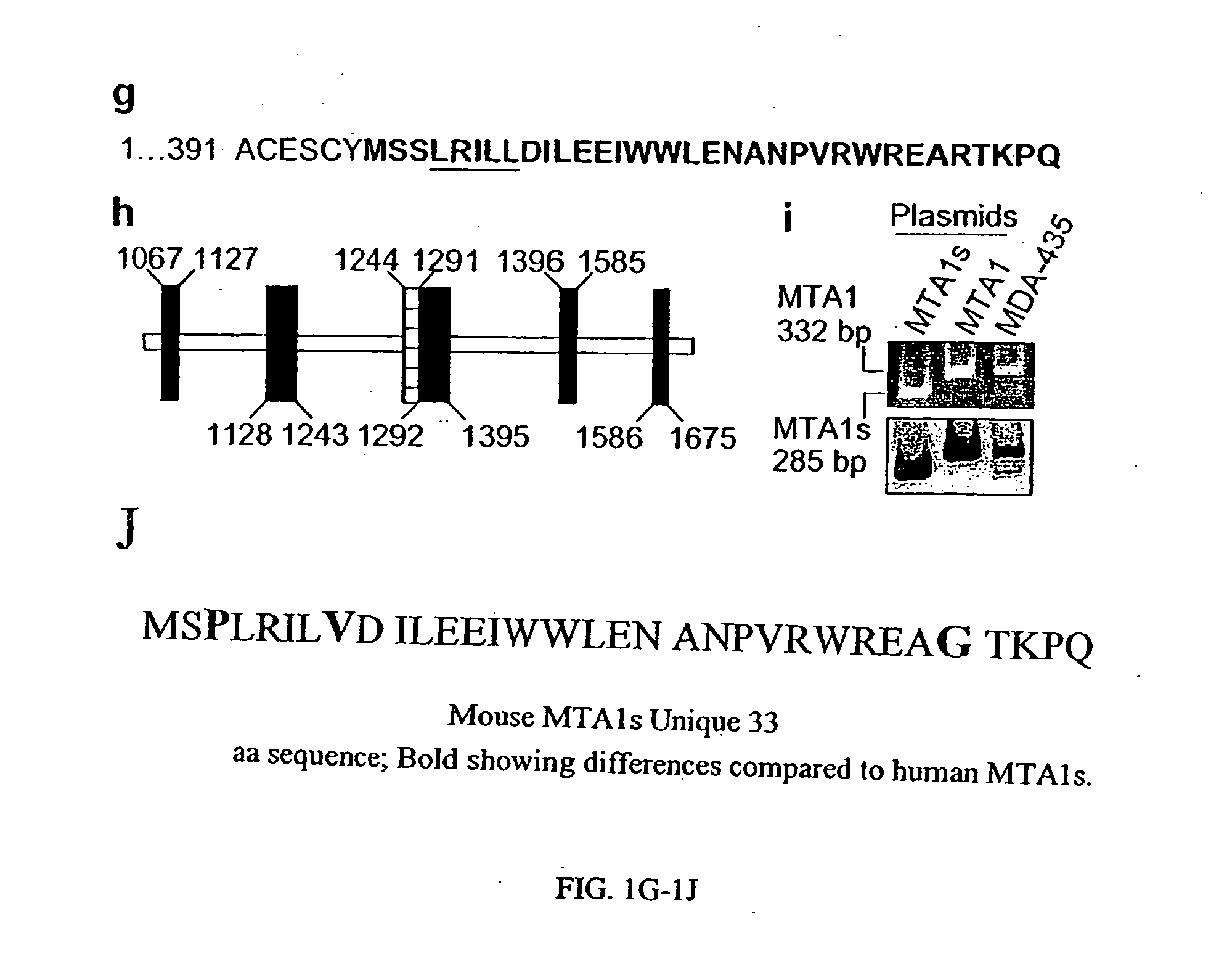Mta1s, a steriod hormone receptor corepressor
- Summary
- Abstract
- Description
- Claims
- Application Information
AI Technical Summary
Benefits of technology
Problems solved by technology
Method used
Image
Examples
example 1
Material and Methods
Cell Cultures and Antibody Development.
[0300] Breast Cancer MCF-7 and ZR-75R cells '4 were maintained in Dulbecco's modified Eagle's medium (DMEM)-F 12 (1:1) supplemented with 10% fetal calf serum. ZR-75R cells were supplemented with I mM sodium pyruvate, and 0.5 μg hydrocortisone / ml. The 20-amino-acid peptide was cross-linked to the keyhole cyanate vector protein and used to immunize New Zealand white rabbits at Research Genetics, Inc. Huntsville, Ala.
[0301] A 290-bp MTA-1 DNA fragment amplified by RT-PCR from the MCF-7 cells was used as a probe to isolate the MTA1 cDNAs from a human mammary gland library (Promega, California). The MTA-1 primer sequences were as follows: SEQ ID NO: 5 forward, 5′-AGCTACGAGGAGGACAACGGG-3′; SEQ ID NO: 6 reverse, 5′-CACGCTTGGTTTCCGAGGAT-3′. MTA1 clones were subcloned into the T7-pcDNA and GST vector. Unique primer sequences to selectively amplify full-length MTA1s cDNAs were: forward primer of SEQ ID NO: 14 was 5′-ATGC...
example 2
Identification of MTA1s Variant
[0313] The MTA1 complementary DNAs (cDNA) of varying lengths from a human mammary gland cDNA library were cloned. The MTA1 cDNA were sequenced and subcloned into pcDNA3.1 expression vector using MTA1 cDNAs open reading frames (FIG. 1A). To investigate the functionality of these clones, MTA1 cDNAs were translated in vitro and resolved the resulted protein products onto SDS-polyacrylamide gels (FIG. 1B). All of the MTA1 clones except the S2 (MTA1s) clone were translated into proteins of expected sizes. The MTA1s clone was translated into a protein of 44 kDa rather than the 70-kDa expected size, based on the MTA1s cDNA length. To confirm the translation of the MTA1s gene in vivo, MCF-7 breast cancer cells were transiently transfected with a T7-tagged MTA1S cDNA, and the protein extracts were analyzed by western blotting with an anti-T7 antibody. The MTA1s clone generated a 54-kDa protein, compared with the 80-kDa protein from the full-length MTA1-T11 (FI...
example 3
MTA1s-Interaction with Bifunctional ATP Sulfurylase / Adenosine 5′-Phosphosulfate Kinase (APS)
[0324] The initiation and promotion of breast cancers is regulated by estrogen stimulation of mammary epithelial cell growth. The estrogen receptor, a principal target of estrogen, is found in about 40% of breast tumors at presentation, together with a profile of ER-regulated genes. These tumors are generally responsive to anti-hormonal therapy but eventually develop resistance. Under physiological conditions, estrogen is inactivated by sulfation by estrogen sulfotransferase (EST), and hence, reducing the responsiveness of the target tissue to estrogenic stimulation (Falany 1997). The process of sulfation is entirely dependent on enzymatic synthesis of an activated sulfate donor (3′-phosphoadenosine 5′-phosphosulfate), generated by a bifunctional ATP sulfurylase / adenosine 5′-phosphosulfate (APS) kinase enzyme (Falany 1997). ER negative breast tumors show high level of EST while ER positive t...
PUM
| Property | Measurement | Unit |
|---|---|---|
| Volume | aaaaa | aaaaa |
| Volume | aaaaa | aaaaa |
| Volume | aaaaa | aaaaa |
Abstract
Description
Claims
Application Information
 Login to View More
Login to View More - R&D
- Intellectual Property
- Life Sciences
- Materials
- Tech Scout
- Unparalleled Data Quality
- Higher Quality Content
- 60% Fewer Hallucinations
Browse by: Latest US Patents, China's latest patents, Technical Efficacy Thesaurus, Application Domain, Technology Topic, Popular Technical Reports.
© 2025 PatSnap. All rights reserved.Legal|Privacy policy|Modern Slavery Act Transparency Statement|Sitemap|About US| Contact US: help@patsnap.com



